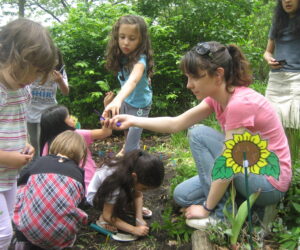
Right next to the Prospect Expressway, at 18th Street and Seventh Avenue, sits a half-acre park in a space left over from when the highway was built through the neighborhood in the late 1950s. Over the last decade, that small slice of land has flourished into Butterfly Garden, a learning garden and barrier-free outdoor classroom taking shape with the Civic Council’s help on the very edge of Park Slope.
The triangular park was first built according to a fairly standard design of the period: fence-enclosed lawns around the perimeter, benches lining the interior, a sandbox at its center. By 2001, though, the tot lot became an eyesore. The grass gave way to dirt; the sandbox was a broken concrete pit, closed off with rusting chicken wire. The park’s location near the expressway’s off-ramp made it a favorite site for dumping trash.

With the park in his backyard, resident Brian Dennigan was acutely aware of its neglected condition. He reached out to the city’s Department of Parks & Recreation not with a complaint but a question: Could he help maintain the park? The department gave him the go-ahead, and he organized his neighbors as a group called HomeGrown to clean up the park.
Over the next few years, HomeGrown transformed the park’s enclosed areas into gardens. Helping the group achieve its goal was Partnerships for Parks, an organization founded in 1995 to adapt the public-private partnership model set by the Central Park Conservancy into neighborhoods where sweat equity is the currency. In 2004, Parks Commissioner Adrian Benepe agreed with HomeGrown that the no-name park deserved to be formally entered on the department’s rolls as Butterfly Garden.
HomeGrown has contributed 500 volunteer gardening hours to Butterfly Garden on average each growing season, every year since 2002. Starting as participants in the Daffodil Project to commemorate 9/11 with flowers, HomeGrown has planted well over 22,000 bulbs of all kinds in the park. Neighbors, often sharing from their own backyard gardens, have contributed butterfly bushes, roses, azaleas, and a range of butterfly-nurturing perennials.
Years ago, at a meeting of ROSAS (Revitalization of the Southern Area of the Slope, a community group “incubated” by the Civic Council), then-Prospect Park Administrator Tupper Thomas pointed out the folly of restoring old parks facilities without ensuring they would be well used by serving constituents’ needs — for example, fixing Prospect Park’s Boathouse because it would become today’s Audubon Center.
Having reclaimed Butterfly Garden, HomeGrown looked for constituents who would make good use of the park. The group had to look no further than its neighbor around the corner, P.S. 10.

In 2009, HomeGrown and the P.S. 10 community forged a partnership to develop Butterfly Garden as an outdoor learning center. P.S. 10 is a magnet school for science, math, and technology. It is also an inclusive, barrier-free school. To ensure the full participation of all P.S. 10 students in Butterfly Garden, the school and community group have been working to modify the park to accommodate physically challenged children. Achieving this aim requires more than sweat equity and in-kind donations: It requires funding.
The Civic Council’s support has been crucial, agreeing to act as HomeGrown’s fiscal sponsor as the group began piecing together grants to outfit the park for its new purpose. Last spring, the partners installed a pair of raised planter boxes accessible to children in wheelchairs, using the old sandpit as a foundation. The design follows Americans with Disabilities Act standards and was done on a pro bono basis by ChoShields Studio [LINK www.choshields.com]; the boxes were built and installed by P.S. 10 parent volunteers. The materials were paid for with grants from Partnerships for Parks and Goldman Sachs.
This June, a second pair of boxes and an outdoor bulletin board will be installed, thanks to funding from Partnerships for Parks and the Citizens Committee for New York City. The partners are looking for sponsors for more raised planters and working with the Parks Department to create ADA-compliant -– but grassed –- pathways throughout the gardens. (The department installed new gates and ramps into the gardens last August.)
P.S. 10’s teachers have been exploring ways to use the gardens in their science and arts curricula. The children observe seasonal changes, sketch, and are inspired to write poetry in the gardens. They’ve researched, laid out, and planted butterfly habitats.
In life-sciences classes, the students raise butterflies from cocoons, releasing them into the gardens. In fact, the release, scheduled this year for May 27, has become an annual, all-school celebration of butterflies.
“The children look forward to this day all year and there is absolute joy on their faces as they watch their butterflies begin to soar,” said lower-grade science teacher Nancy Kaminash. “For the students of P.S. 10 to have this amazing place to plant flowers and watch them grow, or to sit amongst the flowers with their books and read or write, or to observe the nature all around them, is a P.S. 10 treasure. The students feel ownership, pride, responsibility, and absolute delight about this wonderful garden.”
“The Butterfly Garden is P.S. 10’s special place,” a second-grader added. “Whenever we go there, I feel like I’m part of nature.”
— Nancy Dennigan is a co-founder of HomeGrown, a past president of ROSAS, and a long-term member of the Civic Council.
from the May 2011 Civic News

